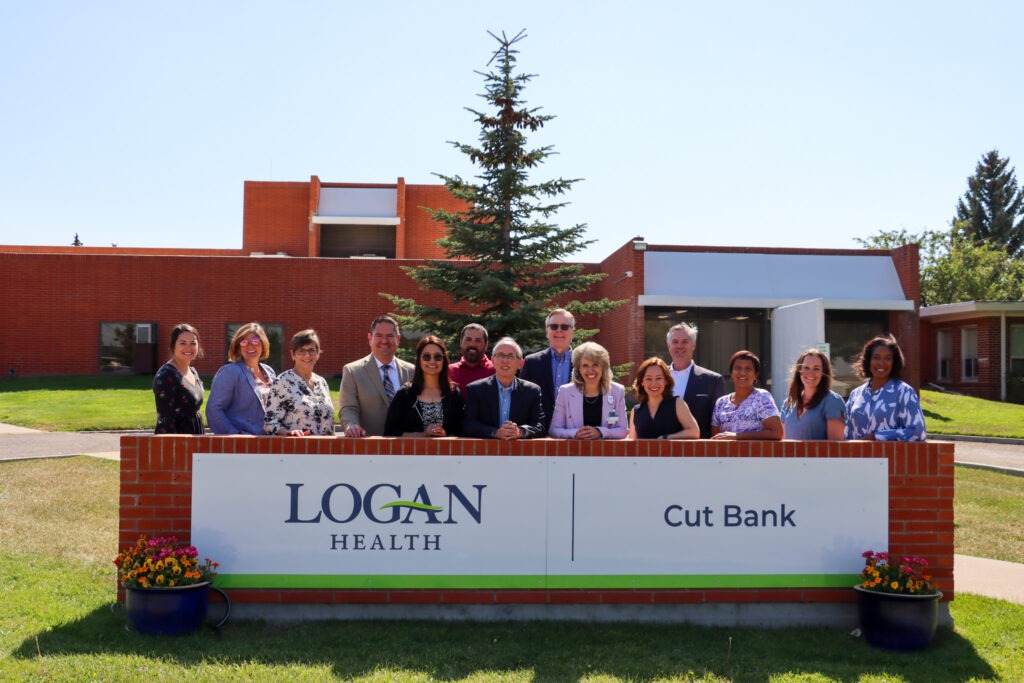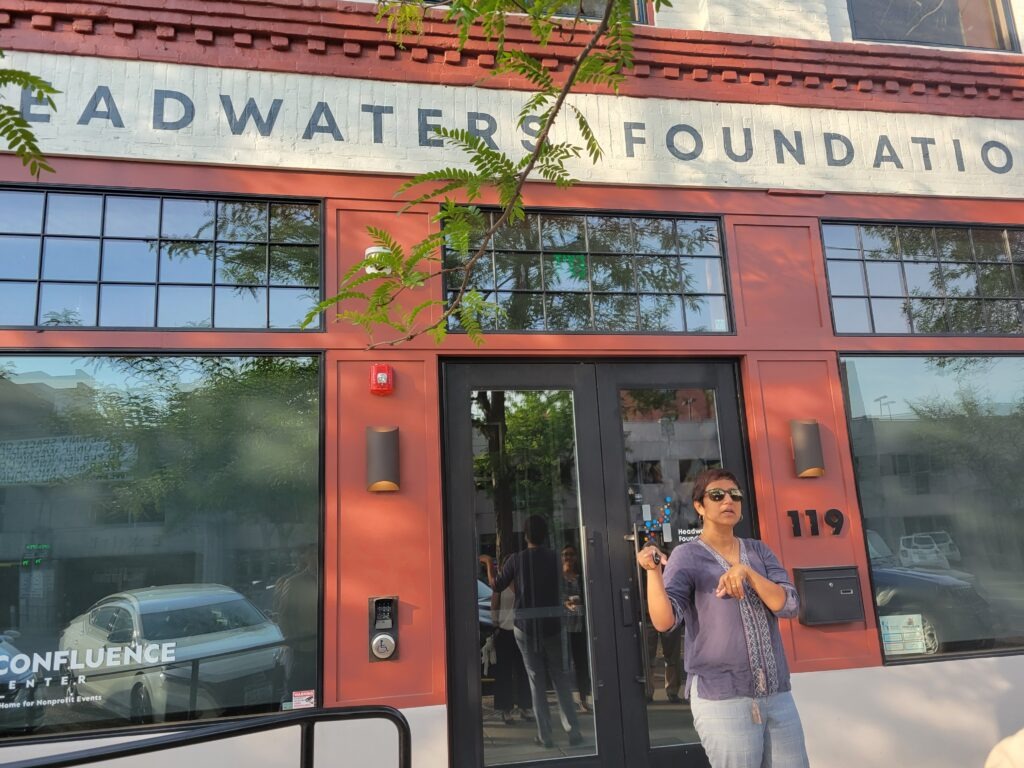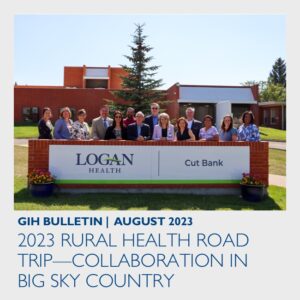Cara V. James, PhD, President and CEO, Grantmakers In Health
It is hard to believe we are approaching the end of summer. It has been a bit of a blur, going from one conference to the next, and planning for fall meetings. For the second year since joining GIH, I was able to participate in our rural health road trip, an annual tradition started by the Federal Office of Rural Health Policy (FORHP) and National Rural Health Association (NRHA) in 2014. I joined the trips in 2017, after becoming co-chair of the Rural Health Council at the Centers for Medicare & Medicaid Services, and I have continued participating in them because of GIH’s long-standing collaboration with FORHP and NRHA, and because the trips are so informative. Our group has grown to include the director of CDC’s new Office of Rural Health and the deputy director of Indian Health Service (IHS). The trips provide an up-close look at some of the challenges rural communities face, how communities are working together to address their challenges, and why solutions that take a one-size-fits-all approach are unlikely to be successful.
This year, we chose to visit Montana, also known as Big Sky Country. Working with two GIH Funding Partners (Headwaters and Montana Healthcare Foundation) and the Montana Office of Rural Health, we mapped a route that began in Helena, then headed north to Great Falls, Shelby, and Cut Bank; west to Ronan; and then south to Missoula. Unfortunately, we were not able to travel to the eastern part of the state, which is more frontier. Despite missing a large portion of the state, we were able to see a lot. We visited hospitals, two tribes, including Little Shell Tribe of Chippewa Indians of Montana, the newest federally recognized tribe, and an urban Indian health organization. We also visited a permanent supportive housing facility, new childcare alliance, community development cooperation, we met with staff from a rural disability research center at the University of Montana, and we spoke with the mayor of Missoula. We ended our trip with a visit to Headwaters Foundation, where we toured their new building.
I am incredibly grateful to Tressie White and Aaron Wernham of Montana Healthcare Foundation, Natalie Claiborne from the Montana Office of Rural Health, and Brenda Solorzano of Headwaters for helping to plan such an amazing trip, and I want to extend a special thanks to Brenda and Natalie for showing us around Montana, and to Brenda’s daughter, Ali, for documenting the trip. I do not have the space to do justice to all that I learned. I highlight a few of my takeaways below, and I know I will be reflecting on the trip for a long time.
A recurring theme throughout the trip was collaboration. As one person said, “We are all working to support the same community.” Starting in Helena, we saw significant evidence of collaboration. The Helena Indian Alliance works closely with PureView Health Center. St. Peter’s Health created a mobile crisis response team that is dispatched through law enforcement that has reduced ED visits and jail time. We saw more examples of collaboration in Cut Bank related to their community paramedicine program, workforce, and services provided. More examples followed in Ronan, where the Confederated Salish and Kootenai Tribes were working with the judicial system to reduce incarceration rates, and Missoula efforts are underway to offer support services to childcare providers. Everywhere we went, communities were working together. Some relationships were long-standing, while others were new.
Policy was also an important recurring theme. From the challenges of getting reimbursed for doing the right thing, to concerns about Medicaid expansion, and the use of Medicaid funding. Providers were beginning to see the effects of Medicaid redeterminations. Justin Murgel, the head of PureView, a federally qualified health center in Helena, said that 11 patients had fallen off in the last two months, compared to hardly any during the last six years. At the Helena Indian Alliance, executive director, Todd Wilson, said they had nine patients fall off. He estimated that about 70 percent of his Medicaid patients obtained coverage through Medicaid expansion.
Several of the people we met with expressed concerns about Medicaid, beyond redetermination. While Montana expanded Medicaid through the Affordable Care Act, the expansion is up for renewal in 2025. Some of those we met with expressed concern that there will not be much support because the prior year’s legislative session was not very “health-friendly,” and several of the legislators who supported Medicaid expansion were no longer in office. KFF estimates that more than 300,000 Montanans are covered by Medicaid.[1] In a state with just over 1.1 million people, the loss of Medicaid would lead to a significant increase in the number of uninsured and decrease the financial situation of the hospitals, clinics, and health systems caring for those individuals.

📷 Alina Caudle
Our trip to Montana provided an opportunity to visit several tribal communities and to learn more about the Indian Health Service and its history. We met with leadership from the Little Shell Chippewa Tribe of Montana, the newest federally recognized tribe, and Confederated Salish and Kootenai Tribes. We also visited Helena Indian Alliance, one of five urban Indian health organizations in Montana. We drove through the Blackfeet reservation on our way from Cut Bank to Ronan, however, we were unable to visit with the tribe. In all three locations, we learned about entities working within a constrained system to provide the care their communities need, and we learned about the impact underfunding to the Indian Health Service has on tribal communities it’s committed to serve.
We also learned about the real-life consequences of historical policies that established and govern IHS. At the Helena Indian Alliance, we learned that while they are a contracted service of IHS, they are unable to bill for a lot of services they provide the way tribes can. As their executive director said, “Whether you like it or not, politics drives how we treat the patients who walk in the door and how we get paid.” In Great Falls, we heard how Little Shell Chippewa Tribe bought an animal hospital and are converting it to a clinic because they could not wait the roughly 15 years it would take for IHS to build one for them. They are modeling their health system after Southcentral Foundation’s Nuka System of Care. With support from the Montana Healthcare Foundation, members of the tribe were able to visit Alaska to see the model first-hand. To help foster collaboration, Montana Healthcare Foundation supports regular convenings of tribal health leaders and some state health officials.
The Confederated Salish and Kootenai Tribes shared several efforts they were implementing to address substance use and homelessness on the reservation. Part of the effort included providing permanent supportive housing, rather than the typical temporary model. Another focus was working to implement the holistic defense model, which comes from the Bronx Defenders, and takes a trauma-informed approach to legal advocacy. This model aligns with the tribe’s mission, which seeks to ensure that cultural values and practice are integrated into every facet of tribal life.
Our trip also highlighted a number of organizations working to address social drivers of health and health care such as housing, food, and child care. St. Peter’s Health discussed their Food Farmacy and Harvest of the Month programs, which aim to improve access to healthy foods and educate students about healthy eating. They also mentioned their focus on food as medicine and trails as medicine, encouraging people to get out and be active. In addition to their work on nutrition security, they shared information about their Housing is Healthcare and Frequent User Services Enhancement (FUSE) initiative, which focuses on supportive housing. In spite of the great work these and other programs we learned about are doing, our hosts expressed frustration with the current system and how it is misaligned. As one speaker at St. Peter’s said, “When you do the right thing, you don’t get paid for it.” They noted their community benefit programs are largely aligned with Medicaid, but the majority of value-based care programs are in Medicare. Representatives from the Missoula Childcare Alliance noted that providing childcare is not generally profitable because nearly all funding comes from parents, and that is not enough to support the full cost of the service. They also shared that Montana has no publicly funded pre-school.

📷 Alina Caudle
Something I was surprised to hear during our visits was people discussing the benefits of the COVID-19 pandemic. In Cut Bank, we learned collaboration was happening as a direct result of funding received in response to the pandemic that required grantees to work with others. As a result, they were working with other providers in the area to address workforce shortages, rather than poach staff from one another. In Ronan, we learned the CARES Act funding made available during the pandemic provided the Confederated Salish and Kootenai Tribes with the money needed to launch the Morningstar Apartment program, a permanent supportive housing program. In Missoula, we learned the pandemic created opportunities for people in childcare to talk to each other in new ways, and to connect across sectors. This helped lay the groundwork for the Missoula Childcare Alliance, a program that aims to connect parents to child care providers, provide space to allow child care providers to co-locate services, and offer shared business services to child care providers.

Brenda Solórzano, CEO, Headwaters Foundation
Finally, it was great to see the importance of philanthropic investment and collaboration in every place we visited. Whether it was funding for a position at St. Peter’s to expand home visiting, support for the Meadowlark program that seeks to improve birth outcomes for persons with substance use disorder, matching grants to native community development financial institutions (CDFIs), innovation or planning grants for behavioral health or childcare, it was clear that Headwaters and Montana Healthcare Foundation, and other foundations, are working hard to improve the lives of all Montanans. It is also clear that in keeping with the main theme of the trip, there is collaboration across funders, as I do not recall hearing of duplicate funding efforts.
I left Montana a little wiser, and much richer for the experience. We often focus on the challenges rural communities face to the detriment of seeing the assets communities bring to the table. The time we spent, albeit not enough to see the eastern half, was plenty to show how Montanans across multiple sectors are working together, learning from others, and adapting models to fit their circumstances. Again, I am grateful to our hosts for helping to organize such an enriching experience, and I look forward to next year’s rural health road trip.
Reference

